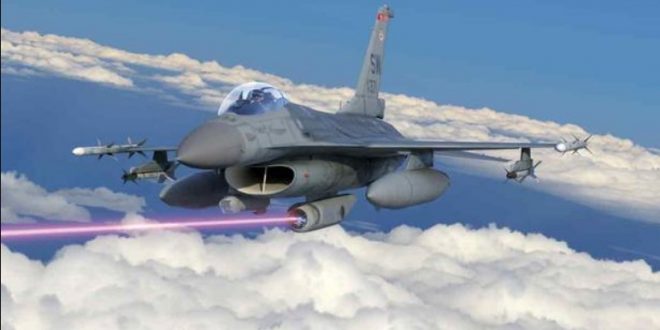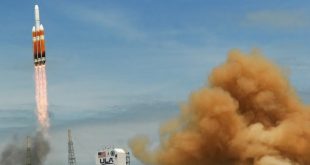The U.S. military’s most recent endeavor to create an airborne laser weapon, designed to safeguard ground troops from incoming ballistic missiles, seems to be on track for abandonment after years of development.
The Self-Protect High-Energy Laser Demonstrator (SHiELD) was launched in 2016 with the aim of developing a laser weapon system to be installed on fighter jets like the F-22 Raptor and F-35 Lightning II. Its purpose is to effectively disable incoming air-to-air and surface-to-air missiles, as well as ballistic missiles that may pose a threat to U.S. military forces stationed overseas. This information is based on a report from the Congressional Research Service in 2023.
The Air Force had initially scheduled the SHiELD system to undergo airborne testing on an F-15 Eagle in fiscal year 2024. In recent years, the service has already reported a successful interception of test missiles using ground-based shootdown techniques and has received the laser weapon system and pod subsystem. However, service officials have indicated that there are no current intentions to finish the weapon and make it operational.
Dr. Ted Ortiz, the program manager of the SHiELD program at the Air Force Research Laboratory’s Directed Energy Directorate, stated in an email to Military.com that the program has ended and there are no intentions for additional testing and evaluation. “The Air Force has not equipped a laser pod on a prototype fighter jet.”
The Air Force has recently abandoned its second attempt at developing an airborne laser weapon, known as SHiELD. In March, Air Force Special Operations Command announced that it had discontinued its efforts to install an Airborne High Energy Laser system, also known as AHEL, on an AC-130J Ghostrider gunship. This decision was made due to the presence of “technical challenges” that persisted even during ground tests, despite achieving “significant end-to-end, high-power operation.”
However, Air Force officials maintain an optimistic outlook on the capacity of airborne laser weapons to fundamentally alter the nature of warfare.
“The Air Force Research Laboratory has made substantial progress in enhancing the preparedness of airborne high-energy laser technology through SHiELD and related initiatives. We are actively developing and refining airborne high-energy laser weapons technology to meet the operational requirements of both present and future scenarios,” stated Ortiz.
The SHiELD program’s termination coincides with the Defense Department’s efforts to enhance air defenses for U.S. troops stationed abroad, in response to the increasing risk of missile attacks from adversaries.
In January 2020, Iran carried out the most extensive ballistic missile strike on American forces overseas to date. This was in retaliation for the U.S. killing of Qasem Soleimani, a high-ranking member of the Islamic Revolutionary Guard Corps. As a result, at least 110 service members suffered from traumatic brain injuries.
Iran-backed militias have recently been targeting U.S. forces in Iraq and Syria, as well as Navy warships in the Red Sea, in retaliation for Israel’s military operations in Gaza. This has led to an increase in traumatic brain injury (TBI) diagnoses among U.S. troops.
Due to the increasing frequency of drone and missile attacks, the Pentagon has shown growing interest in directed-energy weapons like lasers and high-powered microwaves. These weapons have a low cost-per-shot and a virtually unlimited ammunition capacity, making them potentially more cost-effective than current air defense systems. For instance, they could serve as efficient and affordable alternatives to the expensive Coyote interceptor, which costs $125,000 per unit, or the ship-launched Standard Missile-2, which costs $2 million per shot.
In pursuit of this objective, the Army has recently dispatched two ground-based laser weapons abroad to effectively neutralize approaching drones. Additionally, the Army is making substantial investments in the advancement of more potent systems specifically engineered to counter rapidly moving cruise missiles. According to C4ISRNet, the Pentagon is currently allocating approximately $1 billion annually towards at least 31 directed-energy programs.
The deployment of airborne laser weapons for missile defense has been a longstanding objective ever since the Air Force’s Boeing 747-based YAL-1 Airborne Laser Test Bed successfully intercepted ballistic missiles during testing in the 2000s.
Prior to the recent increase in missile attacks on U.S. troops, the Pentagon’s 2019 Missile Defense Review proposed that the development of high-energy laser technology with scalability, efficiency, and compactness could offer a cost-effective means of destroying missiles during their initial trajectory phase. The report also suggested that equipping unmanned aerial vehicles with laser weapons could be an effective defense against ballistic missiles in the arsenals of Russia and China.
According to Breaking Defense, former Pentagon research and engineering chief Mike Griffin explained in 2020 that developing effective and dependable airborne laser weapons has been more difficult compared to their counterparts used on ground vehicles and warships.
The initial issue pertains to the generation of power. Generating the necessary power for lasers from a compact tactical aircraft poses a significant engineering challenge due to the high power requirements of the destructive beam.
The second issue pertains to the beam itself. Despite generating sufficient power, the presence of atmospheric turbulence during combat operations of a fighter jet renders it extremely challenging to sustain a consistent laser beam for a sufficient duration to effectively target and intercept a ballistic missile in mid-flight.
“I believe it is feasible to conduct an experiment, but developing a weapon system that can be installed on an aircraft with the required laser power and all the necessary support systems, while also ensuring that the aircraft can reach altitudes where atmospheric turbulence can be effectively reduced, is not possible on a single platform,” stated Griffin during a conference call with reporters in May 2020, as reported by Breaking Defense.
According to Defense News, approximately one month after Griffin’s remarks, Will Roper, the former Pentagon acquisition chief, stated that the Air Force was reconsidering the possible uses of the laser weapon technology developed under the SHiELD program. The Air Force was exploring options beyond simply incorporating the system into a tactical fighter jet.
Defense News reported that Roper “expressed his intention to engage in a dialogue with the team” in June 2020. Let’s comprehend the various power levels and their appropriate correspondences, and let’s not let the most appealing mission or the most ambitious power level be the only things driving our motivation.
With the conclusion of the SHiELD program and the defunct status of the AHEL, the Defense Department’s aspiration for airborne laser weapons appears as remote as ever. However, considering the Pentagon’s ongoing investment in directed-energy programs to counter the increasing number of enemy drone and missile attacks, it is highly likely that the Air Force’s endeavors in this field are still ongoing.
“According to Ortiz, after a lengthy period of development, HEL weapons have now become a tangible presence on the battlefield.” Putting HEL weapons on air platforms is a natural next step because of their innovative features, such as their large ammunition capacity, adaptable impact, and ability to hit targets at the speed of light. Using jet fuel as ammunition also makes sense from a practical standpoint.
 Tech Gadget Central Latest Tech News and Reviews
Tech Gadget Central Latest Tech News and Reviews




